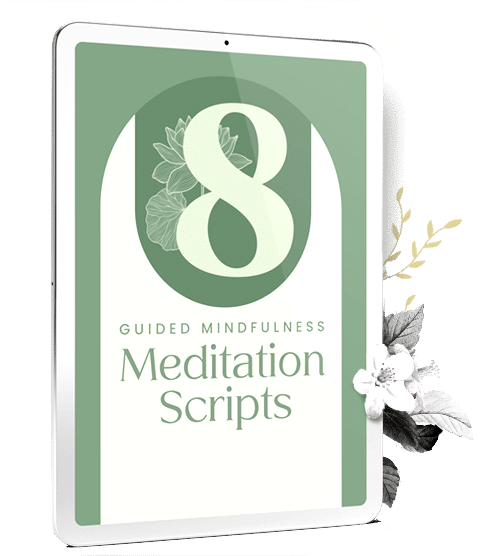The world is changing quickly, and as it does, so do the ways that we live, work, connect, and teach. From global pandemic restrictions to the ease of reaching a wider audience, there are a variety of reasons that many mindfulness teachers are choosing to teach mindfulness online. But are online mindfulness classes the same as in-person classes? As a teacher, how can we enhance our online teachings to increase engagement and efficacy?
In this comprehensive guide on how to teach mindfulness online, we will explore:

Why Teach Mindfulness Online?
Connecting with people on the other side of this planet has never been easier. In the grand scheme of things, it was not long ago that connection to distant regions was possible only by telephone call, boat, or plane. Technology has boomed in recent decades, giving birth to online training programs and classes.
As a mindfulness teacher, what are some of the reasons we might consider teaching online? There are a variety of factors that might motivate us to share our offerings virtually, including:
Depending on who you are and who your audience is, online mindfulness classes may be well-suited for you. The internet and associated technologies undoubtedly broaden the way that we can share our practices and insights with the world. Online teachings do not have to replace in-person classes entirely. In fact, many teachers are offering hybrids with both online and in-person classes.
If you are new to teaching mindfulness and have not yet certified, you can also consider online mindfulness training programs. Online mindfulness courses make it easier for us to learn from world-renowned teachers. We can study from the comfort of our own homes and some programs enable us to take our studies at our own pace. Learn more about the flexible online mindfulness training program offered through Mindfulness Exercises.

“Our work is to educate people that the ultimate source of the happy individual, happy family, happy community, and finally happy humanity—even happy world—ultimately depends on warm-heartedness. This is not just the concern of religious people; it is the concern of humanity as a whole.”
-The Dalai Lama-
The Challenges of Online Mindfulness Classes
While teaching mindfulness virtually has a range of benefits, there are also some challenges worth making note of. Increasing our awareness of these challenges can inform us of steps we might take to minimize the potential drawbacks.
Sense of isolation
While technological advancements have increased connection in one sense, it is important to be mindful that learning online can also come with a sense of isolation. We lose the joy of being together face-to-face. To mitigate this challenge, you might consider offering both in-person and online offerings to suit a variety of needs – and, you might think of ways to boost interaction and a sense of community (as noted below).
Lack of interaction
When we go to a meditation class in-person, there is naturally time before and after a session to connect with other students and the teacher. This is more challenging during online teachings, so it is important to consider different ways of facilitating interaction and communication (i.e. through an online community space or chat section).
Accessibility issues
Furthermore, accessibility issues are something to be mindful of when teaching online. This might be due to lack of equipment or due to computer literacy challenges. It is important to ask ourselves if our students will be able to access our online programs, and if not, to consider how we might support them.
Data privacy and security
Computer security and data privacy is another challenge to be mindful of. That being said, there are many ways to use technology safely. Look into the data storage policies of any platforms you use and take precautions to address potential security issues.
Inhibited perception of cues
Additionally, online classes often inhibit our ability to perceive cues that indicate what students are experiencing during a meditation – especially if their video is turned off. One way of managing this is to ask questions before a session to better understand the needs and experience levels of participants. During the session, you can empower your students to do what they need to do in order to best care for themselves. Offer a variety of options where appropriate (such as different attention anchors to return to).
Technological difficulties
Finally, another challenge that we often disregard until we are confronted by it is that of tech difficulties. What happens if the power goes out during our session? What if students are late because of a new software update? Consider what you can do to prepare for any technological challenges that might come up, having backups where you can.

9 Tips for How to Teach Mindfulness Online
After reading about some of the challenges of teaching mindfulness online, you might already have come up with new ways of increasing engagement and efficacy in your teachings. For more ideas on how you can teach mindfulness online in inspiring and supportive ways, consider the following tips.
1. Explore your options
Before you begin sharing online, consider the different software programs available to you. What will be easiest for your students to access? What privacy concerns do you need to be aware of? Gather as much data and shared experience as you can to make the best decision for you and your students.
2. Do a trial run with a friend.
Once you have determined what platform or software you will use, do a test run with someone close to you. This can be helpful to get a sense of volume, music integrations, and the admission process. Additionally, it is a way of smoothing out some of the potential challenges before you jump right in.
3. Deliver clear instructions prior to the class.
Next, once you have planned and promoted a class, make sure you deliver clear instructions for your students before they tune in. For example, do they need to have anything with them? Is there a password they will need to login? These considerations when clearly communicated will help to reduce any confusion or anxiety that some people might feel before an online class.
4. Encourage engagement early in the session.
Furthermore, once the class has begun, encourage engagement as soon as possible. For example, if there is a chat section in your chosen software, invite each participant to state their name and where they’re tuning in from. You could also make space for verbal introductions if this suits your timing and group. Another easy way to encourage engagement is by offering a reflection question. Reflections do not need to be shared with the group; rather, this is a subtle and thoughtful way of helping participants to tune in.

“Perhaps the secret of living well is not in having all the answers but in pursuing unanswerable questions in good company.”
- Rachel Naomi Remen-
5. Create comfort with a clear outline and different options for tuning in.
At the start of a session, outline the flow that your participants can expect. This is particularly important for longer classes. For instance, will there be time allocated for a bathroom break? Will there be time for questions at the end? Additionally, consider offering your students the option to tune in with or without their video. This can help to increase comfort and reduce anxiety.
6. Consider breakout rooms for more interactive sessions.
If you are offering a more interactive class, you can further encourage interaction by leading students into breakout rooms. This is a great opportunity for students to connect with one another and it can enhance what they take away from the class.
7. Be available after the class for questions and reflections.
When the class is over, let participants know that you will be around for any questions or comments. If time does not permit, encourage students to reach out by email if they wish to. This can help to ensure that your students feel supported.
8. Solicit feedback from your students.
At the end of a session, consider sending your students a feedback form. Is there something they particularly liked about the class? Is there something that didn’t quite work for them? This invaluable feedback will help you to better plan future sessions.
9. Share free mindfulness resources for continued practice.
Lastly, online mindfulness classes offer us the ability to easily share recommended readings, worksheets, and other exercises. Share free mindfulness resources with your students to encourage their continued mindfulness exploration.

6 Mindfulness Resources to Share During Online Mindfulness Classes
If you teach mindfulness meditation online and are looking for mindfulness exercises to share with your students, consider these six resources as a place to start. There are an infinite number of free mindfulness exercises to explore, so take your time to choose practices and readings that are best suited for your attendees.
If you explored mindfulness of breathing during your session, you might offer your students a worksheet on another breathing technique to try: the perfect 10 breaths practice. This exercise guides us to slowly count out ten sequential breaths and to reflect on the practice afterwards.
You might also share this list of 10 mindfulness journal prompts with your students after class to facilitate continued learning. Mindful journaling is a great way of exploring what is present for us and prompts offer us a thoughtful place to start.
If you would like to help your students explore a new relationship to their emotions, consider offering this mindfulness of emotions worksheet. This practice guides us to investigate the physical qualities of a given emotion as it appears in the body.
Another wonderful practice to share with students is that of gratitude. This mindfulness worksheet includes a meditation and reflection exercise to increase awareness of various things to be thankful for.
To help your students develop a routine of mindfulness, consider sharing this article with them. It outlines simple exercises and considerations for establishing a daily practice (along with common barriers to practice that many people experience).
Lastly, you might consider sharing a self-compassion worksheet with your students for continued compassionate exploration. This practice includes a self-guided meditation and associated reflection exercise.
Instantly download 300 mindfulness worksheets to share with your students.
The types of resources that you offer to your participants will of course depend on the needs of your group, the type of meditation you led, and any questions that arose from the session. It can be helpful to create a mindfulness toolkit with a variety of different practices and exercises that you can pull from any time you need to.
So, is teaching mindfulness online the same as in-person? In one sense, yes. Since mindfulness can be practiced no matter where we are, no matter how the teaching is delivered, much remains the same whether online or in-person. With that said, online settings offer unique opportunities and challenges. Use these insights and tips to be mindful of any challenges that might arise when teaching online and to enhance the invaluable gift you are offering to the world.














